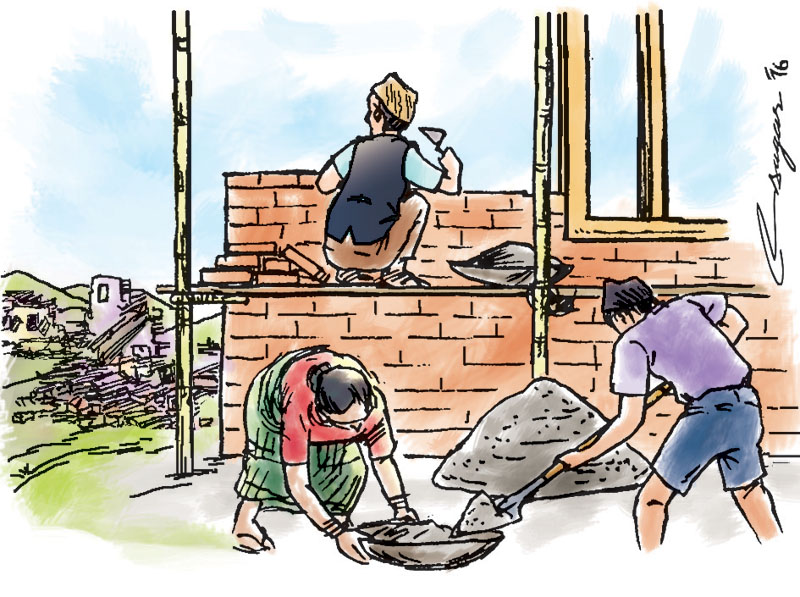Building back better: Some key aspects
The reconstruction process will need to incorporate locally usable materials to the shear and tensile strength currently used in stone masonry construction technology to make more resilient buildings
The Post Disaster Needs Assessment has revealed that the recent earthquakes have disproportionately affected poorer, rural locations, comparative to the urban and semi urban area. The Human Development Index (HDI) of nine out of 14 severely affected districts is lower than the national average. Except Kathmandu, Bhaktapur and Patan, all the affected areas are rural areas. If the reconstruction process is delayed or not designed to address the local and national context, the losses will continue to amplify, pushing more locals below the poverty line.
Therefore, a properly designed reconstruction package presents exciting avenues for Nepal to rise from the ashes of the earthquake. The best way this may be done is by evolving the current definition and utility of a Nepali “Village”. This can be achieved through encouraging integrated settlements in rural areas through the creation of livelihood, educational and health opportunities revolving around a village center.
This will present an opportunity to make these rural areas more economically vibrant, thus retaining the youth force and discouraging migration to urban centers and abroad. Most importantly, the planning and construction of these new-concept villages will cultivate a culture of safe construction generating a more resilient community.
The process of rehabilitation and creating a culture of safer construction can be established through training of local engineers and masons, building awareness in the local community, and capacity building in the local government. The earthquake reconstruction program provides an opportunity not only for developing resilient infrastructure and physical facilities but also for initiating economic activities that will result in long term self-reliance, leading to a sustainable rural economy.
The conventional approach for reconstruction has been to construct physical facilities where the role of local communities has been limited to assisting with the respective projects. Although ‘Building Back Better’ (BBB) or building resilient infrastructure may be possible from this conventional approach, the outcome, as observed in post-disaster reconstruction of many developing countries, is usually worse than before. This is because no economic vitalization is considered, making it almost impossible for the affected communities to break the vicious cycle of poverty and vulnerability to natural hazards. The Center of Resilient Development (CoRD) is proposing a new concept in reconstruction, which not only guarantees resilient physical facilities but also provides opportunities for sustainable economic development at a local level.
Hence, the reconstruction process will need to incorporate locally usable materials to the shear and tensile strength currently used in stone masonry construction technology to make more resilient buildings. It is not a viable option to change the conventional approach drastically as this will require imported materials and also requires a technology external to the local communities.
The newly reconstructed Town-Villages are most essentially an opportunity for a community to start anew. The planned infrastructure of these communities will break down barriers that previously encouraged urban and international migration.
This will be achieved through the establishing of modern amenities like electricity and the Internet, and a village centre which will have key communal facilities like schools, markets and health centres. This level of planning and facilities will enable the Town-Villages to attract trade and business partners from urban areas, and in the long run will facilitate urban to regional migration, bringing in an influx of funds and new entrepreneurial ventures to these communities. This will present a new solution in terms of job creation for Nepal’s labour force, which the International Labour Organization (ILO) estimates will rise by more than 30% or 4.7 million citizens between the years 2015 and 2030.
In addition to these key components, the reconstruction policy and approach should also consider a number of other interventions. These approaches can be implemented through a three-pronged strategy. Firstly, the concept of the Town-Village will need to be endorsed by the National Planning Commission (NPC), Government of Nepal. Secondly, the NPC will have to advise the guidelines for how the planning and evaluations for the Town-Village will be carried out. Finally, it needs to be endorsed and enforced by the Ministry of Federal Affairs and Local Development (MoFALD) at the local level.
Application of these plans to the 14 most affected districts of the Gorkha Earthquake will be a catalyst in generating a culture of safer construction practices nationwide. The primary lesson from the Gorkha earthquake is that local construction methods are not sustainable in terms of safety, and like the 14 affected districts, the 5 million plus buildings in the other 61 districts are prone to the same fate in the case of future earthquakes. Therefore, it is equally important to extend sustainable practices to these other districts regardless of whether the projects will involve brand new construction or the retrofitting of existing buildings. With this we can create a resilient Nepalese society.
Shrestha is Associate Professor, Tribhuvan University






